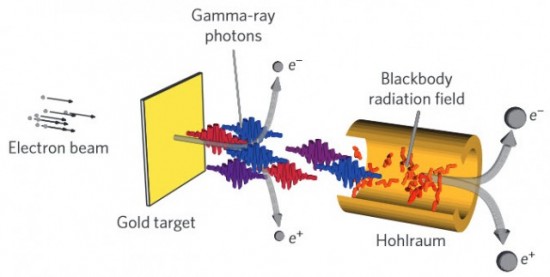By smashing massless photons together, light can be converted into matter, according to physicists at London’s Imperial College, and the race to conduct the experiment is on–and should be carried out within the year. Until now, the idea of converting E into mc2 had been considered practically impossible.
“The race to carry out and complete the experiment is on,” said Imperial College London’s Oliver Pike. The experiment is now possible because physicists are able increase the number of photons to massive levels (billions of times the level of normal visible light) in order to achieve collisions in a photon-photon collider. The tiny size of photons was until recently a near-impossible obstacle to the experiment.
The proposed means of achieving massive photon levels is a photon-photon collider in a vacuum hohlraum. The apparatus consists of a high-powered laser, which bombards a slab of gold, producing a high-intensity gamma ray (photons) a hallow space (“hohlraum”) in which is accumulated a thick field of photons produced by another laser. The gamma ray bombards the hohlraum. Out of the other end of the hohlraum some electrons and positrons will fly, according to the English physicists. A shorter, more technical phrasing of the process is that a gamma-ray beam is fired into the high-temperature radiation field of a laser-heated hohlraum.
The theory of converting light into matter and matter into light dates back to 1930, when theoretical physicist Paul Dirac considered that an electron and its antimatter counterpart (a positron) could be annihilated (combined) to produce two photons. Four years later, physicists Gregory Breit and John Wheeler suggested that the reverse could also be true.
“It’s breathtaking to think that things we thought are not connected, can in fact be converted to each other: matter and energy, particles and light. Would we be able in the future to convert energy into time and vice versa?” said John Adams Institute, Oxford Director Andrei Seryi of the John Adams Institute on the matter.
Many laboratories around the world have the equipment necessary to perform the experimental photon-photon collisions, the English physicists say, and the experiment is expected to be conducted within the year.
By Andy Stern
